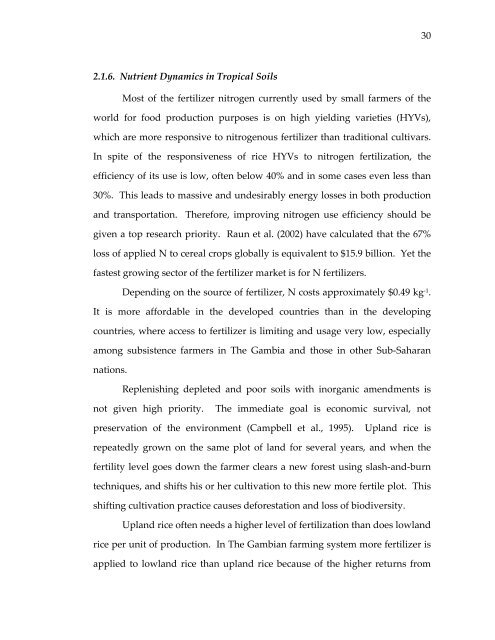Management of rice production systems to increase productivity
Management of rice production systems to increase productivity
Management of rice production systems to increase productivity
Create successful ePaper yourself
Turn your PDF publications into a flip-book with our unique Google optimized e-Paper software.
2.1.6. Nutrient Dynamics in Tropical Soils<br />
Most <strong>of</strong> the fertilizer nitrogen currently used by small farmers <strong>of</strong> the<br />
world for food <strong>production</strong> purposes is on high yielding varieties (HYVs),<br />
which are more responsive <strong>to</strong> nitrogenous fertilizer than traditional cultivars.<br />
In spite <strong>of</strong> the responsiveness <strong>of</strong> <strong>rice</strong> HYVs <strong>to</strong> nitrogen fertilization, the<br />
efficiency <strong>of</strong> its use is low, <strong>of</strong>ten below 40% and in some cases even less than<br />
30%. This leads <strong>to</strong> massive and undesirably energy losses in both <strong>production</strong><br />
and transportation. Therefore, improving nitrogen use efficiency should be<br />
given a <strong>to</strong>p research priority. Raun et al. (2002) have calculated that the 67%<br />
loss <strong>of</strong> applied N <strong>to</strong> cereal crops globally is equivalent <strong>to</strong> $15.9 billion. Yet the<br />
fastest growing sec<strong>to</strong>r <strong>of</strong> the fertilizer market is for N fertilizers.<br />
Depending on the source <strong>of</strong> fertilizer, N costs approximately $0.49 kg ‐1 .<br />
It is more affordable in the developed countries than in the developing<br />
countries, where access <strong>to</strong> fertilizer is limiting and usage very low, especially<br />
among subsistence farmers in The Gambia and those in other Sub‐Saharan<br />
nations.<br />
Replenishing depleted and poor soils with inorganic amendments is<br />
not given high priority. The immediate goal is economic survival, not<br />
preservation <strong>of</strong> the environment (Campbell et al., 1995). Upland <strong>rice</strong> is<br />
repeatedly grown on the same plot <strong>of</strong> land for several years, and when the<br />
fertility level goes down the farmer clears a new forest using slash‐and‐burn<br />
techniques, and shifts his or her cultivation <strong>to</strong> this new more fertile plot. This<br />
shifting cultivation practice causes deforestation and loss <strong>of</strong> biodiversity.<br />
Upland <strong>rice</strong> <strong>of</strong>ten needs a higher level <strong>of</strong> fertilization than does lowland<br />
<strong>rice</strong> per unit <strong>of</strong> <strong>production</strong>. In The Gambian farming system more fertilizer is<br />
applied <strong>to</strong> lowland <strong>rice</strong> than upland <strong>rice</strong> because <strong>of</strong> the higher returns from<br />
30
















